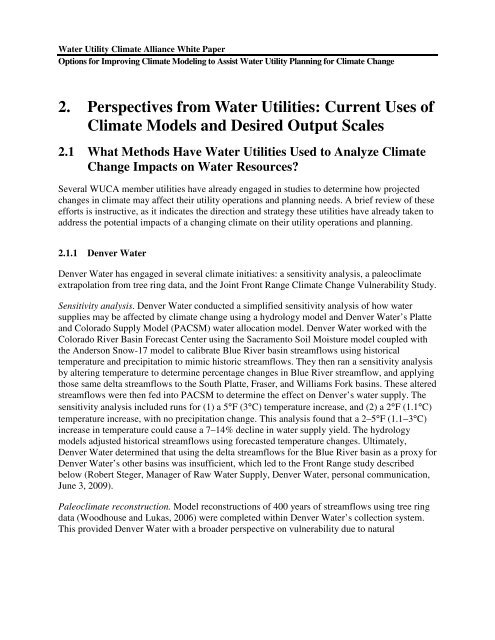Options for Improving Climate Modeling to Assist Water Utility ...
Options for Improving Climate Modeling to Assist Water Utility ...
Options for Improving Climate Modeling to Assist Water Utility ...
You also want an ePaper? Increase the reach of your titles
YUMPU automatically turns print PDFs into web optimized ePapers that Google loves.
<strong>Water</strong> <strong>Utility</strong> <strong>Climate</strong> Alliance White Paper<br />
<strong>Options</strong> <strong>for</strong> <strong>Improving</strong> <strong>Climate</strong> <strong>Modeling</strong> <strong>to</strong> <strong>Assist</strong> <strong>Water</strong> <strong>Utility</strong> Planning <strong>for</strong> <strong>Climate</strong> Change<br />
2. Perspectives from <strong>Water</strong> Utilities: Current Uses of<br />
<strong>Climate</strong> Models and Desired Output Scales<br />
2.1 What Methods Have <strong>Water</strong> Utilities Used <strong>to</strong> Analyze <strong>Climate</strong><br />
Change Impacts on <strong>Water</strong> Resources?<br />
Several WUCA member utilities have already engaged in studies <strong>to</strong> determine how projected<br />
changes in climate may affect their utility operations and planning needs. A brief review of these<br />
ef<strong>for</strong>ts is instructive, as it indicates the direction and strategy these utilities have already taken <strong>to</strong><br />
address the potential impacts of a changing climate on their utility operations and planning.<br />
2.1.1 Denver <strong>Water</strong><br />
Denver <strong>Water</strong> has engaged in several climate initiatives: a sensitivity analysis, a paleoclimate<br />
extrapolation from tree ring data, and the Joint Front Range <strong>Climate</strong> Change Vulnerability Study.<br />
Sensitivity analysis. Denver <strong>Water</strong> conducted a simplified sensitivity analysis of how water<br />
supplies may be affected by climate change using a hydrology model and Denver <strong>Water</strong>’s Platte<br />
and Colorado Supply Model (PACSM) water allocation model. Denver <strong>Water</strong> worked with the<br />
Colorado River Basin Forecast Center using the Sacramen<strong>to</strong> Soil Moisture model coupled with<br />
the Anderson Snow-17 model <strong>to</strong> calibrate Blue River basin streamflows using his<strong>to</strong>rical<br />
temperature and precipitation <strong>to</strong> mimic his<strong>to</strong>ric streamflows. They then ran a sensitivity analysis<br />
by altering temperature <strong>to</strong> determine percentage changes in Blue River streamflow, and applying<br />
those same delta streamflows <strong>to</strong> the South Platte, Fraser, and Williams Fork basins. These altered<br />
streamflows were then fed in<strong>to</strong> PACSM <strong>to</strong> determine the effect on Denver’s water supply. The<br />
sensitivity analysis included runs <strong>for</strong> (1) a 5°F (3°C) temperature increase, and (2) a 2°F (1.1°C)<br />
temperature increase, with no precipitation change. This analysis found that a 2–5°F (1.1−3°C)<br />
increase in temperature could cause a 7–14% decline in water supply yield. The hydrology<br />
models adjusted his<strong>to</strong>rical streamflows using <strong>for</strong>ecasted temperature changes. Ultimately,<br />
Denver <strong>Water</strong> determined that using the delta streamflows <strong>for</strong> the Blue River basin as a proxy <strong>for</strong><br />
Denver <strong>Water</strong>’s other basins was insufficient, which led <strong>to</strong> the Front Range study described<br />
below (Robert Steger, Manager of Raw <strong>Water</strong> Supply, Denver <strong>Water</strong>, personal communication,<br />
June 3, 2009).<br />
Paleoclimate reconstruction. Model reconstructions of 400 years of streamflows using tree ring<br />
data (Woodhouse and Lukas, 2006) were completed within Denver <strong>Water</strong>’s collection system.<br />
This provided Denver <strong>Water</strong> with a broader perspective on vulnerability due <strong>to</strong> natural

















